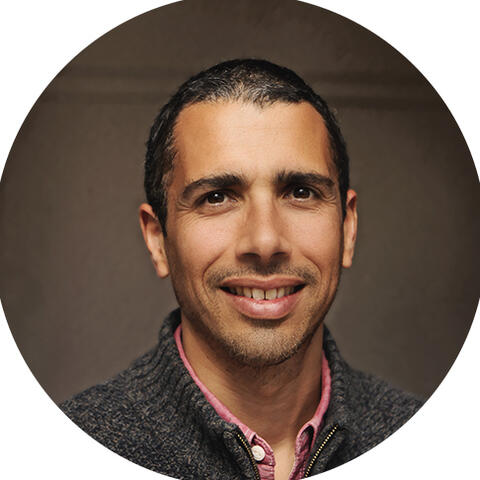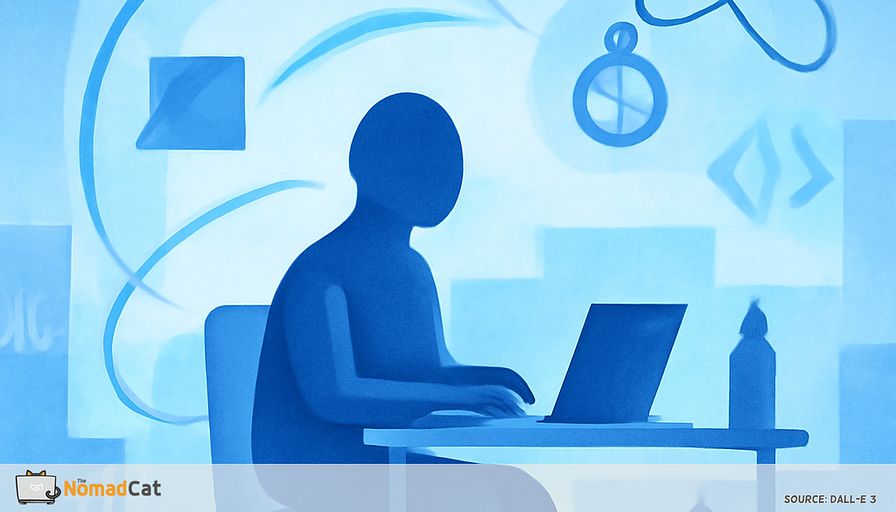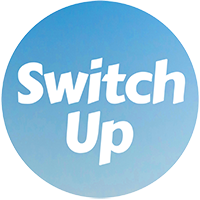Abstract:
The article explores the challenges and solutions of maintaining physical movement as a solo tech worker, especially when working long hours in small or minimalist spaces without the natural prompts of an office environment. Drawing from personal experiences—such as working alone in a Lisbon apartment or Berlin coworking spaces—the author highlights how even ergonomic setups and post-work exercise often fail to counteract the aches, low energy, and health risks of prolonged sitting. The core message is that integrating frequent, tiny movements—like stretching during code compilations, rolling shoulders after hitting ‘commit,’ or placing a water bottle just out of reach—can significantly improve comfort, mood, and focus. The author favors analog prompts like kitchen timers and sticky notes, and habit-stacking movement with existing digital tasks, over digital reminders or specialized equipment. Practical, gear-free micro-movements for the upper and lower body and eyes are described, all designed to fit seamlessly into any workspace. The article emphasizes building flexible, self-compassionate routines, tracking progress with visible, low-tech tools like notebooks or bead counters, and adapting habits to real work patterns rather than rigid schedules. Ultimately, the author frames these micro-movements as a natural, essential part of solo tech work, showing that small, consistent changes can have a lasting positive impact on well-being and productivity.
Long hours at the desk can sneak up fast, can’t they? Even with a decent chair and careful setup, that stiff neck and tired back keep showing up. Sometimes it feels impossible to get through a tech day without feeling like a robot stuck in one pose for hours. I once believed a quick workout after work would fix everything, but my body disagreed. The aches and dips in energy kept coming, no matter how many ergonomic tweaks I tried.
The real challenge for me as a solo tech worker is this: without office noise or teammates dropping by, it’s easy to forget to move at all. Routines blur, especially when there’s no strict schedule or space for fancy gear. It’s not just about comfort—there’s that nagging worry about the long-term risks of sitting still too long. Tiny moves, just a stretch or a stand-up now and then, actually make a difference. They help my body, mood, and focus. Still, making these breaks automatic is easier said than done, especially when working alone in a small space.
Why does something so simple feel so tricky, and what actually works to keep movement in the mix, even when the workday gets intense? Let’s look at small ways to make movement part of the solo tech routine, and why these little changes matter more than they seem.
Why tiny moves matter
Everyday science behind moving at your desk
Even on days when I sit in a pretty ergonomic chair, grinding through hours of code, my neck and back get tense. There’s just no way around it. My smartwatch flags “stand up” alerts after 30-minute blocks, and skipping two alerts in a row always ends with neck stiffness. Bodies aren’t made to stay frozen for hours. Moving every half hour, even if it’s just standing up or stretching my arms for a minute, keeps my energy up and my neck less stiff. These little breaks aren’t only about dodging back pain. They change how I feel and work, helping my diabetes/managing/eat-well/keeping-blood-sugar-normal.html">blood sugar and mood stay steadier day after day.
Throwing in these tiny movement snacks makes a real difference for my mind too. My favourite trick is to use slow compile times to stretch. I feel more awake and can focus again. It’s not about turning work into a gym session, just breaking up the stillness. My brain is sharper after a stretch. On days when I hit five mini-breaks, my post-lunch slump drops from 30 to 10 minutes (measured with RescueTime logs).
I used to think a daily run would balance out my laptop marathons, but spreading out movement works better for me. Even quick moves, standing or a few shoulder rolls, lower long-term risks like heart disease and diabetes. That’s big, especially for anyone glued to a laptop for years. So if small moves help so much, why is it so tough for solo tech workers to stick with them?
The solo tech setup: why it’s easy to forget to move
Working solo, with no office chats or coffee runs, it’s ridiculously easy to lose track of time. Sometimes I realise it’s been hours since I stood up, especially in my little apartment in Lisbon. No colleagues popping by for a joke or random meeting, so there are no signals to take a break. It gets even trickier with a flexible schedule—without set meetings or lunch times, I lose track of both time and movement. My physics background always made me love structure and patterns, but solo tech work keeps testing that every day. Space is another big limit for remote tech workers.
Lots of friends working remotely, especially in big cities, have tiny, cluttered setups. No room for yoga mats, sometimes not even for a proper chair. That’s why I stick to mini-moves: quick, gear-free, subtle stretches that fit anywhere. So, how do I make movement automatic in a solo, minimalist tech workflow?
Make moves routine
Turning digital tasks into movement moments
My tech days come packed with little pauses—waiting for code to build, slow uploads, running test suites. After years of chasing productivity, I started using these waiting windows as natural movement triggers. For example, when I hit ‘deploy’, I stand up and roll my shoulders a few times. If tests are running, I stretch my wrists or sway from side to side while reading logs. These tiny rituals fit right into my workflow, no awkward timer apps or forced reminders needed.
Here are a few ways I pair movement with desk work:
- Stand up and stretch while code compiles—30 seconds is enough.
- Shoulder rolls right after hitting ‘commit’ to shake off tension.
- Stretch wrists while waiting for a database restore.
- Turn my neck side to side during a slow upload, just to keep things loose.
These self-made cues beat any reminder app or calendar notification. The more I tie movement to tech steps, the more normal it feels, like brushing my teeth after breakfast. It just blends into my day.
Habit chains beat digital reminders
If you work solo, task-based cues often beat digital reminders, at least for me. The pattern is simple: finish a digital task, move, start the next. It’s like sneaking a little subroutine into my day. No need for motivation or nagging alarms, the habit stacks naturally, piggybacking on my work patterns.
This habit stacking also fits a minimalist setup. Digital reminders add clutter, but workflow triggers ride along on routines I already have, quietly making movement automatic. A few weeks in, I barely think about it.
No gadgets, just habit
I love that this approach needs no gadgets or apps, just a simple mental link between desk events and movement. By month two, these mini-moves become as natural as hitting ‘save’ after an edit.
For anyone who hates extra reminders and digital noise, minimalist cues do the trick just as well. Building these habits keeps my space, and my mind, clear.
Simple reminders for more movement
Non-digital prompts that work
Too many notifications drive me a bit crazy, so I avoid most reminder apps. Instead, I use simple analog cues: a kitchen timer ticking by my laptop, a sticky note on the monitor, or even placing my water bottle just out of reach so I have to stand. My favourite low-key tricks:
- Kitchen timer for regular breaks—just the sound nudges me up.
- Sticky note on the monitor, a bright reminder in my line of sight.
- Water bottle across the room, so I have to get up to drink.
They cut digital clutter and gently nudge me to move. Sometimes the simplest prompts work best.
But if you prefer something digital without extra fuss, there are options too.
Lightweight scripts for digital nudges
When I lived in Berlin, I wrote a small terminal script that flashes a message at the end of each Pomodoro interval, just a quick nudge that it’s time to move. It felt nice and minimal, right in line with my tech habits and a tidy workspace. No pop-ups everywhere, just one little line after a work sprint.
Tactile ways to keep score
Paper trackers or moving a bead along a string after every break give a small sense of progress. It’s oddly rewarding, like ticking off a to-do. No tech needed, just a pen or a bead that slides every time I take a quick stretch.
In April, my bead line hit 132 moves—averaging six per workday. Seeing the coloured beads stack up felt as satisfying as closing tickets in Jira.
These prompts make it more easy to remember to move. Next comes the question, what should I actually do during those quick breaks, especially in a tight or gear-free workspace?
A minimalist menu of mini-moves for busy tech days
Upper body stretches without leaving your chair
Years at a keyboard and my neck and wrists always complain first. A simple chin tuck, just pulling my chin slightly backward like trying to make a double chin, does wonders for my neck, especially after long coding sessions. I go slow, holding each tuck for a few seconds. For my shoulders, slow circles backward and forward, maybe eight or ten times, quickly untie the knots that build up from typing.
For wrists, I do gentle stretches that take less than 30 seconds and keep those little aches away. My go-to moves:
- Hold one arm out, palm down, and lightly pull the fingers toward me.
- Flip the hand, palm up, and gently pull the fingers back.
- Circle my wrists or wiggle my fingers for a few seconds to get blood flowing.
These moves need no special space or equipment. They slip into the day whether I’m at home in Lisbon or in a cramped coworking spot.
I do these stretches while reading logs or waiting for a build. They’re discreet—even in a coworking space nobody notices. The same minimalist approach works for the lower body and even for my eyes.
Lower body and eye relief in tight spaces
Sitting all day tightens my hips and knees, especially in a small Lisbon flat. I like the seated figure four stretch: crossing one ankle over the opposite knee, leaning forward a bit, and holding for a few breaths. A few bodyweight squats by the chair or standing calf raises while waiting for a file upload shake out the stiffness. Even with almost no space, these mini-moves fit right in and keep my legs from turning into stone.
Eyes need breaks too. The 20-20-20 rule helps: every 20 minutes, look at something 20 feet away for 20 seconds. I keep a tiny note near my monitor as a reminder. After a day sticking to this, there’s less burning and way fewer headaches.
All these moves are practically invisible, perfect for small or shared spaces. Blending mini-moves into my day keeps my workspace minimalist, my body less stiff, and my eyes feeling much better. Making these movements a habit is the real challenge.
Building sustainable mini-move habits
Adapting movement routines to your real workday
No two days at my desk ever look quite the same. Sometimes it’s hours of deep focus on a tough bug, other times endless video meetings fill the day.
Workflow always changes. What works for me is tying mini-moves to the flow of work, not to the clock. Stretching after every commit, standing up right after each meeting ends, or rolling my wrists before launching a big build keeps friction low and the habit sticks. I’m not forcing a rigid system—my triggers move along with my tasks. Adapting movement to what really happens in the day, not an ideal one, feels far more sustainable.
Routines need to stay flexible to survive real life, and tracking habits in a visible, tactile way makes a big difference. When I lived in Berlin, I kept a paper checklist right on my desk. Each tick for a stretch or movement break was a small reward. Watching the marks accumulate during the week felt satisfying. A wall calendar or a simple coloured chart does the same trick. It’s proof of progress and keeps me going even when days are busy.
Sometimes I skip a break or two, or double up later to make up. Life gets in the way. The main thing is to make the habit fit reality and let go of chasing a perfect record. Flexible routines bounce back faster and don’t leave me feeling guilty about missed breaks.
Getting back on track after missed days
Self-compassion is key for consistency. Everyone misses a day or even a week, no matter how solid the habit was before. When I fall behind, the way back is gentle. I restart with just one mini-move per hour, bundled onto something I’m already doing, like making tea or opening my morning dashboard.
Missing a few breaks doesn’t erase all the previous effort. Self-compassion keeps me steadier over time than obsessing over perfect streaks or relying on a tracking app for motivation. If boredom sets in, changing the routine helps. I’ll swap my usual wrist stretch for bodyweight squats or move the cue from code deploy to the start of each calendar event. Finding routines that last, even without a team cheering me on, lets me keep going year after year.
Building a culture of movement in solo tech work
Making self-accountability natural and minimalist
Tracking movement breaks is as important to me as checking any key performance indicator. Maybe it’s my physics background, but I like numbers and trends. I use a simple notebook or a wall calendar to log each mini-move. No tricky dashboards, just a visible way to see if I’m keeping up.
Every mark on paper is proof I’m making movement real, and it feels almost like closing a bug after a tough fix. Low-tech tools work best. Marking a tally or sliding a bead is far less distracting than another app pinging on my laptop. It’s real feedback, not digital clutter.
These analog systems also help me spot patterns, like when I skip breaks or when my energy dips. By glancing at my wall tracker, I can quickly see what needs tweaking, almost like debugging code. Over time these simple cues turn mini-moves into just another part of my solo workflow.
Sustaining movement as an everyday habit
The less effort it takes to remember a habit, the longer it stays. Linking movement to my workflow and keeping cues visible helps everything fade into the background. It’s always there, never a burden. Habits like these stick because they piggyback on what’s already happening.
Routines always need to adapt. Life keeps shifting—moving from Berlin to Lisbon, starting a new project, reorganising my workspace. Staying curious and flexible keeps the process interesting and the habit alive.
For me, movement is just another work routine, woven right into the hours at my desk. Treating it as part of my job, not a special act of self-care, makes it stick. These mini-moves have become as normal as checking email or reviewing code, an essential part of how I work solo every day.
Making mini-moves part of my solo tech routine changed a lot for me. Those little stretches and stand-ups, tied to daily tasks, help me stay more comfortable, focused, and even a bit lighter in spirit. I don’t need fancy gear or reminders, just a few simple tricks, a bit of kindness toward myself, and cues that match my real workday. I feel the warmth return to my fingertips after a 20-second wrist roll. The benefits go far beyond less neck pain or tired eyes. My energy lasts longer, my mood stays steadier, and the work feels less heavy. It shows me that small habits add up, even in a tight space or unpredictable schedule. I often ask myself which tiny movement I will try next time I wait for code to compile. Sometimes the smallest changes stick the longest and make the biggest difference.














